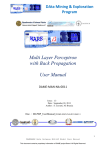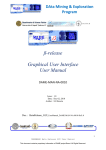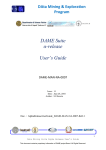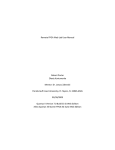Download Fast Multi Layer Perceptron with Genetic Algorithm User Manual
Transcript
DAta Mining & Exploration
Program
Fast Multi Layer Perceptron
with Genetic Algorithm
User Manual
DAME-MAN-NA-0012
Issue: 1.3
Author: M. Brescia, A. Solla
Doc. : FMLPGA_UserManual_DAME-MAN-NA-0012-Rel1.3
1
DAMEWARE FMLPGA Model User Manual
This document contains proprietary information of DAME project Board. All Rights Reserved.
DAta Mining & Exploration
Program
INDEX
1
2
Introduction ................................................................................................................................................ 4
FMLPGA Model Theoretical Overview .................................................................................................... 5
2.1 Multi Layer Perceptron ....................................................................................................................... 5
2.2 The Genetic Algorithms .................................................................................................................... 10
2.3 MLP Practical Rules ......................................................................................................................... 14
2.3.1
Selection of neuron activation function ..................................................................................... 14
2.3.2
Scaling input and target values .................................................................................................. 15
2.3.3
Number of hidden nodes ............................................................................................................ 15
2.3.4
Number of hidden layers............................................................................................................ 16
3 Use of the web application model ............................................................................................................ 17
3.1 The fastest parallel GPU-based version (FMLPGA) ........................................................................ 17
3.2 Use Cases .......................................................................................................................................... 18
3.3 Input .................................................................................................................................................. 19
3.4 Output ............................................................................................................................................... 20
3.5 TRAIN Use case ............................................................................................................................... 21
3.5.1
Regression with FMLPGA – Train Parameter Specifications ................................................... 21
3.5.2
Classification with FMLPGA – Train Parameter Specifications ............................................... 24
3.6 TEST Use case .................................................................................................................................. 27
3.6.1
Regression with FMLPGA – Test Parameter Specifications ..................................................... 27
3.6.2
Classification with FMLPGA – Test Parameter Specifications ................................................ 29
3.7 Run Use case ..................................................................................................................................... 31
3.7.1
Regression with FMLPGA – Run Parameter Specifications ..................................................... 31
3.7.2
Classification with FMLPGA – Run Parameter Specifications ................................................. 33
4 Examples .................................................................................................................................................. 36
4.1 Regression XOR problem ................................................................................................................. 36
4.1.1
Regression FMLPGA – Train use case...................................................................................... 37
4.1.2
Regression FMLPGA – Test use case ....................................................................................... 40
5 Appendix – References and Acronyms .................................................................................................... 42
2
DAMEWARE FMLPGA Model User Manual
This document contains proprietary information of DAME project Board. All Rights Reserved.
DAta Mining & Exploration
Program
TABLE INDEX
Tab. 1 – output file list in case of regression type experiments ....................................................................... 20
Tab. 2 – output file list in case of classification type experiments .................................................................. 20
Tab. 3 – Abbreviations and acronyms ............................................................................................................. 42
Tab. 4 – Reference Documents ........................................................................................................................ 43
Tab. 5 – Applicable Documents....................................................................................................................... 44
FIGURE INDEX
Fig. 1 – the MLP artificial and biologic brains ................................................................................................ 5
Fig. 2 – the step function ................................................................................................................................... 6
Fig. 3 – the ramp function ................................................................................................................................. 6
Fig. 4 – the sigmoid function ............................................................................................................................. 6
Fig. 5 – the tanh function .................................................................................................................................. 7
Fig. 6 – Example of a SLP to calculate the logic AND operation ..................................................................... 8
Fig. 7 – A MLP able to calculate the logic XOR operation .............................................................................. 8
Fig. 8 – A typical Genetic Algorithm optimization research mechanism ........................................................ 10
Fig. 9 – An example of genetic cross over operator application..................................................................... 11
Fig. 10 – An example of genetic mutation operator application ..................................................................... 12
Fig. 11 – A MLP network trained by a Genetic Algorithm ............................................................................. 13
Fig. 12 – Steps of the algorithm related to genetic algorithm evolution ......................................................... 14
Fig. 13 – The sigmoid function and its first derivative .................................................................................... 15
Fig. 14 – The computing time comparison between FMLPGA training execution on CPU and GPU
platforms. The experiment was based on 1000 input patterns, each one composed by 10 parameters. ......... 17
Fig. 15 – The computing time speedup for FMLPGA on CPU and GPU platforms. The function axis is
referred to the different chromosome selection type used during training (evolution of genetic population) 18
Fig. 16 – The content of the xor.csv file used as input for training/test use cases .......................................... 19
Fig. 17 – The content of the xor_run.csv file used as input for Run use case ................................................. 19
Fig. 18 – The starting point, with a Workspace (FMLPGAExp) created and two data files uploaded........... 36
Fig. 19 – The xorTrain experiment configuration tab ..................................................................................... 37
Fig. 20 – The xorTrain experiment status after submission ............................................................................ 38
Fig. 21 – The xorTrain experiment output files ............................................................................................... 38
Fig. 22 – The files error (left) and weights (right) output of the xorTrain experiment ................................... 39
Fig. 23 – The file “weights” copied in the WS input file area for next purposes ............................................ 40
Fig. 24 – The xorTest experiment configuration tab (note “weights” file inserted) ....................................... 40
Fig. 25 – The xorTest experiment output files ................................................................................................. 41
3
DAMEWARE FMLPGA Model User Manual
This document contains proprietary information of DAME project Board. All Rights Reserved.
DAta Mining & Exploration
Program
1 Introduction
T
he present document is the user guide of the data mining model FMLPGA (Fast Multi Layer
Perceptron trained by Genetic Algorithms), as implemented and integrated into the DAMEWARE.
This manual is one of the specific guides (one for each data mining model available in the webapp) having
the main scope to help user to understand theoretical aspects of the model, to make decisions about its
practical use in problem solving cases and to use it to perform experiments through the webapp, by also
being able to select the right functionality associated to the model, based upon the specific problem and
related data to be explored, to select the use cases, to configure internal parameters, to launch experiments
and to evaluate results.
The documentation package consists also of a general reference manual on the webapp (useful also to
understand what we intend for association between functionality and data mining model) and a GUI
user guide, providing detailed description on how to use all GUI features and options.
So far, we strongly suggest to read these two manuals and to take a little bit of practical experience
with the webapp interface before to explore specific model features, by reading this and the other
model guides.
All the cited documentation package is available from the address
http://dame.dsf.unina.it/dameware.html, where there is also the direct gateway to the webapp.
As general suggestion, the only effort required to the end user is to have a bit of faith in Artificial
Intelligence and a little amount of patience to learn basic principles of its models and strategies.
By merging for fun two famous commercial taglines we say: “Think different, Just do it!”
(casually this is an example of data (text) mining...!)
4
DAMEWARE FMLPGA Model User Manual
This document contains proprietary information of DAME project Board. All Rights Reserved.
DAta Mining & Exploration
Program
2 FMLPGA Model Theoretical Overview
This paragraph is intended to furnish a theoretical overview of the FMLPGA model, associated to single or
multiple functionality domains, in order to be used to perform practical scientific experiments with such
techniques. An overview of machine learning and functionality domains, as intended in DAME Project can
be found in [A18].
2.1 Multi Layer Perceptron
The MLP architecture is one of the most typical feed-forward neural network model. The term feed-forward
is used to identify basic behavior of such neural models, in which the impulse is propagated always in the
same direction, e.g. from neuron input layer towards output layer, through one or more hidden layers (the
network brain), by combining weighted sum of weights associated to all neurons (except the input layer).
huma
Fig. 1 – the MLP artificial and biologic brains
As easy to understand, the neurons are organized in layers, with proper own role. The input signal, simply
propagated throughout the neurons of the input layer, is used to stimulate next hidden and output neuron
layers. The output of each neuron is obtained by means of an activation function, applied to the weighted
sum of its inputs. Different shape of this activation function can be applied, from the simplest linear one up
to sigmoid, or tanh (or a customized function ad hoc for the specific application).
5
DAMEWARE FMLPGA Model User Manual
This document contains proprietary information of DAME project Board. All Rights Reserved.
DAta Mining & Exploration
Program
Step function
y = 1 if x >= 0, 0 if x < 0
Fig. 2 – the step function
The step function is the most similar to biological neuron reaction to external stimuli. In this case in fact, it
uses a constant activation threshold to propagate the signal. It is useful only in problem solving where it is
needed a crisp classification between two well identified classes.
Ramp function
y = x if x is internal to [-1, 1]
Fig. 3 – the ramp function
It is also known as identity function in the [-1, 1] range. Useful only when the network output is unbounded.
Sigmoid function
y = 1/(1+e^(-x))
Fig. 4 – the sigmoid function
6
DAMEWARE FMLPGA Model User Manual
This document contains proprietary information of DAME project Board. All Rights Reserved.
DAta Mining & Exploration
Program
This function is the most frequent in the MLP model. It is characterized by its smooth step between 0 and 1
with a variable threshold. But this restricted domain [0, 1] is also its limitation. It in fact can be used only in
problems where expected outputs are numbers in this range.
Hyperbolic tangent function
y = tanh(x)
Fig. 5 – the tanh function
The hyperbolic tangent is very similar to the sigmoid except for the output range [-1, 1] and that it across the
origin of axes. It therefore extends the admissible range of network output1.
For the output units, activation functions suited to the distribution of the target values are:
•
•
•
•
For binary (0/1) targets, the logistic sigmoid function is an excellent choice;
For continuous-valued targets with a bounded range, the logistic and hyperbolic tangent functions
can be used, where you either scale the outputs to the range of the targets or scale the targets to the
range of the output activation function ("scaling" means multiplying by and adding appropriate
constants);
If the target values are positive but have no known upper bound, you can use an exponential output
activation function, but you must beware of overflow;
For continuous-valued targets with no bounds, use the identity or "linear" activation function (which
amounts to no activation function) unless you have a very good reason to do otherwise.
The base of the MLP is the Perceptron, a type of artificial neural network invented in 1957 at the Cornell
Aeronautical Laboratory by Frank Rosenblatt. It can be seen as the simplest kind of feedforward neural
network: a linear classifier. The Perceptron is a binary classifier which maps its input x (a real-valued vector)
to an output value f(x) (a single binary value) across the matrix.
1
Despite of the above considerations, it is well known that it is always possible to shift the center of the
activation function by introducing the bias value associated to each neuron. By this way it is always possible
to obtain values in the [–∞, +∞] range. But in this case it is suggested to use a linear transfer function.
7
DAMEWARE FMLPGA Model User Manual
This document contains proprietary information of DAME project Board. All Rights Reserved.
DAta Mining & Exploration
Program
where w is a vector of real-valued weights and
is the dot product (which computes a weighted
sum). b is the 'bias', a constant term that does not depend on any input value. The value of f(x) (0 or 1) is
used to classify x as either a positive or a negative instance, in the case of a binary classification problem.
If b is negative, then the weighted combination of inputs must produce a positive value greater than | b | in
order to push the classifier neuron over the 0 threshold. Spatially, the bias alters the position (though not the
orientation) of the decision boundary.
The Perceptron learning algorithm does not terminate if the learning set is not linearly separable. The
Perceptron is considered the simplest kind of feed-forward neural network.
The earliest kind of neural network is a Single Layer Perceptron (SLP) network, which consists of a single
layer of output nodes; the inputs are fed directly to the outputs via a series of weights. In this way it can be
considered the simplest kind of feed-forward network. The sum of the products of the weights and the inputs
is calculated in each node, and if the value is above some threshold (typically 0) the neuron fires and takes
the activated value (typically 1); otherwise it takes the deactivated value (typically -1).
Fig. 6 – Example of a SLP to calculate the logic AND operation
Neurons with this kind of activation function are also called artificial neurons or linear threshold units, as
described by Warren McCulloch and Walter Pitts in the 1940s.
A Perceptron can be created using any values for the activated and deactivated states as long as the threshold
value lies between the two. Most perceptrons have outputs of 1 or -1 with a threshold of 0 and there is some
evidence that such networks can be trained more quickly than networks created from nodes with different
activation and deactivation values. SLPs are only capable of learning linearly separable patterns. In 1969 in a
famous monograph entitled Perceptrons Marvin Minsky and Seymour Papert showed that it was impossible
for a single-layer Perceptron network to learn an XOR function.
Although a single threshold unit is quite limited in its computational power, it has been shown that networks
of parallel threshold units can approximate any continuous function from a compact interval of the real
numbers into the interval [-1,1]. So far, it was introduced the model Multi Layer Perceptron.
Fig. 7 – A MLP able to calculate the logic XOR operation
8
DAMEWARE FMLPGA Model User Manual
This document contains proprietary information of DAME project Board. All Rights Reserved.
DAta Mining & Exploration
Program
This class of networks consists of multiple layers of computational units, usually interconnected in a feedforward way. Each neuron in one layer has directed connections to the neurons of the subsequent layer. In
many applications the units of these networks apply a continuous activation function.
The number of hidden layers represents the degree of the complexity achieved for the energy solution space
in which the network output moves looking for the best solution. As an example, in a typical classification
problem, the number of hidden layers indicates the number of hyper-planes used to split the parameter space
(i.e. number of possible classes) in order to classify each input pattern.
The universal approximation theorem [R12] for neural networks states that every continuous function that
maps intervals of real numbers to some output interval of real numbers can be approximated arbitrarily
closely by a multi-layer Perceptron with just one hidden layer. This result holds only for restricted classes of
activation functions, e.g. for the sigmoidal functions.
An extension of the universal approximation theorem states that the two layers architecture is capable of
universal approximation and a considerable number of papers have appeared in the literature discussing this
property. An important corollary of these results is that, in the context of a classification problem, networks
with sigmoidal non-linearity and two layer of weights can approximate any decision boundary to arbitrary
accuracy. Thus, such networks also provide universal non-linear discriminate functions. More generally, the
capability of such networks to approximate general smooth functions allows them to model posterior
probabilities of class membership. Since two layers of weights suffice to implement any arbitrary function,
one would need special problem conditions, or requirements to recommend the use of more than two layers.
Furthermore, it is found empirically that networks with multiple hidden layers are more prone to getting
caught in undesirable local minima.
Astronomical data do not seem to require such level of complexity and therefore it is enough to use just a
double weights layer, i.e. a single hidden layer.
What is different in such a neural network architecture is typically the learning algorithm used to train the
network. It exists a dichotomy between supervised and unsupervised learning methods.
In the first case, the network must be firstly trained (training phase), in which the input patterns are
submitted to the network as couples (input, desired known output). The feed-forward algorithm is then
achieved and at the end of the input submission, the network output is compared with the corresponding
desired output in order to quantify the learning quote. It is possible to perform the comparison in a batch way
(after an entire input pattern set submission) or incremental (the comparison is done after each input pattern
submission) and also the metric used for the distance measure between desired and obtained outputs, can be
chosen accordingly problem specific requirements (usually the euclidean distance is used).
After each comparison and until a desired error distance is unreached (typically the error tolerance is a precalculated value or a constant imposed by the user), the weights of hidden layers must be changed
accordingly to a particular law or learning technique.
After the training phase is finished (or arbitrarily stopped), the network should be able not only to recognize
correct output for each input already used as training set, but also to achieve a certain degree of
generalization, i.e. to give correct output for those inputs never used before to train it. The degree of
generalization varies, as obvious, depending on how “good” has been the learning phase. This important
feature is realized because the network doesn’t associates a single input to the output, but it discovers the
relationship present behind their association. After training, such a neural network can be seen as a black box
able to perform a particular function (input-output correlation) whose analytical shape is a priori not known.
In order to gain the best training, it must be as much homogeneous as possible and able to describe a great
variety of samples. Bigger the training set, higher will be the network generalization capability.
Despite of these considerations, it should be always taken into account that neural networks application field
should be usually referred to problems where it is needed high flexibility (quantitative result) more than high
precision (qualitative results).
Second learning type (unsupervised) is basically referred to neural models able to classify/cluster patterns
onto several categories, based on their common features, by submitting training inputs without related
9
DAMEWARE FMLPGA Model User Manual
This document contains proprietary information of DAME project Board. All Rights Reserved.
DAta Mining & Exploration
Program
desired outputs. This is not the learning case approached with the MLP architecture, so it is not important to
add more information in this document.
2.2 The Genetic Algorithms
The Genetic Algorithms (GAs) are computational methods inspired by the natural evolution law discovered
by Darwin. They are particularly powerful to solve problems where the solution space is not well defined.
The algorithm hence consists mainly in the cyclic exploration of the parameter space, carefully going
towards the best solution. In a GA each element of a population is the so-called chromosome, composed by a
set of genes (features), that represents its DNA. Each DNA is in practice one possible solution to the
problem. The starting point of the method consists in the random generation of a population of
chromosomes, for example by using normal or uniform statistical distributions. The method proceeds by
performing cyclic variation and combination of the initial population, looking for the best population (best
problem solution). At each evolution stage the output chromosomes are obtained by applying several genetic
operators to the input population and by evaluating through a specific fitness function the goodness of the
new generated population. The fitness function has the basic role to give a method to discard worst
chromosomes from the population, achieving the evolution to the next generation of the best candidates only
(exactly like Nature works with its species, following the Darwin’s law). Typical genetic operators are crossover and mutation.
Fig. 8 – A typical Genetic Algorithm optimization research mechanism
In the design of a GA to solve an optimization problem, three steps are considered as strategic to obtain
better results in the better time: the chromosome representation (codified in some way); the choice of the
fitness function and the method to choose chromosome reproduction. The latter in particular deals with the
issue that no random choices can be applied to select chromosomes to be combined by the genetic operator
employed in the algorithm. Otherwise, the convergence could result too slow. The choice must be “driven”
in some way. Usual rules are the so-called roulette wheel selection and tournament selection. The former
mainly consists into the assignment of a probability to be selected for the reproduction for each chromosome.
This probability is directly proportional to its fitness. The latter is alternatively based on the random choice
of a number N of chromosomes from the current population and to compare their fitness: the element with
the best fitness is the winner and is selected for reproduction.
10
DAMEWARE FMLPGA Model User Manual
This document contains proprietary information of DAME project Board. All Rights Reserved.
DAta Mining & Exploration
Program
The tournament selection seems quite flexible, because it permits to introduce more variability in the
selection criterion: higher N, lower the possibility to select chromosomes candidates with worst fitness!
Anyway, not always the elements with worst fitness must be considered bad choices for reproduction. They
in fact, introduce more variety in the population (exactly like the jumping out from a local minima for the
gradient descendent learning algorithm in the BP…), and can speed up the convergence towards best
solution. But their use must be taken under control in the GA. For example by monitoring population
evolution, where some chromosome has a static trend (i.e. it has always associated a good fitness but not
sufficient to become a winner during reproduction, so remaining always the same through several
generations). In this case, by applying any reproduction with a chromosome randomly chosen between those
with poor fitness, can introduce gain in the next generations.
Usually (but not always) in the tournament selection two winners are chosen at a time (i.e. from two
tournaments) and recombined to generate two sons put in the next generation. As said before, two are typical
genetic operators employed in the chromosome recombination:
The Cross-over (or unbiased chromosome cross-over) criterion, on two m-length chromosomes A and B,
brakes original parents at a fixed position j (j is the number of genes or sub-string length arbitrarily fixed a
priori). So the m-j genes of chromosome A are queued to the first j genes of chromosome B, while the m-j
genes of chromosome B are queued to the first j genes of chromosome A.
Fig. 9 – An example of genetic cross over operator application
Example:
A = 10010001, B = 00110111, m = 8 and j = 5 => after cross-over => A’ = 10010111, B’ = 00110001
After the cross-over application, the two sons A’ and B’ are obtained from their parents by reciprocally
reverting last m-j (3) genes.
11
DAMEWARE FMLPGA Model User Manual
This document contains proprietary information of DAME project Board. All Rights Reserved.
DAta Mining & Exploration
Program
After cross-over, usually it is applied another genetic operator, mutation. It consists into the roughly change
in only one gene inside the chromosome. Depending on the code used to represent the chromosome genes
(typical is the binary code), the original value of a gene is replaced by the other character. There are two
different mutation criteria: unbiased and biased. Both criteria can be applied to an entire chromosome as well
as to a single gene.
Fig. 10 – An example of genetic mutation operator application
In the single gene unbiased mutation (standard mutation type), one position inside the chromosome string is
randomly selected. Then the gene related to the selected chromosome string position is replaced. In the
unbiased chromosome mutation, the entire selected chromosome is completely replaced by a new
chromosome, randomly generated. In the biased chromosome mutation, the selected chromosome is totally
replaced by a new chromosome, obtained by the sum of original chromosome and a new one randomly
generated (in this sense biased).
Generally, neither the cross-over and mutation operators are always applied to all population members, but
the first usually with a certain pre-defined probability (typical is 70% of population members), while the
second with a lower probability and only to members with associated poor fitness.
This procedure (serial application of selected genetic operators) is applied until the new population has
exactly the same member number of the previous one. And the entire cycle of population generation is
iterated until the chromosome with desired good fitness is founded.
Now, having introduced the computing model architecture and the learning algorithm, we are ready to
combine them into the FMLPGA model.
12
DAMEWARE FMLPGA Model User Manual
This document contains proprietary information of DAME project Board. All Rights Reserved.
DAta Mining & Exploration
Program
Fig. 11 – A MLP network trained by a Genetic Algorithm
In the DM model the GA technique is used to change weights related to hidden layers during the learning
phase (corresponding to the backward step of BP algorithm). In this case the chromosomes are represented
by the weight vectors associated with neuron layers, where the single neuron weight is a gene of the string.
By evolving populations of network weights, through the application of described genetic operators, the
model is able to converge (generally faster than weight gradient descendent of BP) to the best solution. In
other words, at each step of genetic evolution, a population of neural networks (identified by its weight
vectors) is generated. The fitness function in this case is simply the calculated error of MLP output by
applying standard feed-forward propagation of the input patterns through the network layers. The winner
chromosome will be therefore the MLP weight configuration obtaining the lower output error. Moreover, in
this case, to maintain the integrity of the MLP feed-forward calculations, the genes are not coded but leaved
exactly as weight double values (usually normalized between -1 and 1).
The formulas showed in Fig. 11 are cyclically repeated during training. It is hence evident that the learning
algorithm can be divided into two phases: bottom-up propagation and top-down weight update.
The complete algorithm involves the following steps:
1. Random generation of the initial genetic population of chromosomes (population of different
network weight vectors);
2. Forward propagation of a training pattern's input through the neural network in order to generate the
propagation's output activations. This step is repeated for each network weight matrix (a single
chromosome of the genetic population);
3. Calculation of training error (batch mode) as MSE of distances between network output and related
target values;
4. Evaluation of the output performance on all patterns against the genetic fitness function (for each
chromosome);
13
DAMEWARE FMLPGA Model User Manual
This document contains proprietary information of DAME project Board. All Rights Reserved.
DAta Mining & Exploration
Program
5. Generation of a new population of chromosomes, by applying genetic operators to the weight vectors
of the network;
6. Repeat steps from 2 to 5 until the number of training cycles or the chosen error threshold has been
reached.
Fig. 12 – Steps of the algorithm related to genetic algorithm evolution
2.3 MLP Practical Rules
The practice and expertise in the machine learning models, such as MLP, are important factors, coming from
a long training and experience within their use in scientific experiments. The speed and effectiveness of the
results strongly depend on these factors. Unfortunately there are no magic ways to a priori indicate the best
configuration of internal parameters, involving network topology and learning algorithm.
But in some cases a set of practical rules to define best choices can be taken into account.
2.3.1
•
Selection of neuron activation function
If there are good reasons to select a particular activation function, then do it
o linear;
o threshold;
o Hyperbolic tangent;
14
DAMEWARE FMLPGA Model User Manual
This document contains proprietary information of DAME project Board. All Rights Reserved.
DAta Mining & Exploration
Program
•
•
o sigmoid;
General “good” properties of activation function
o Non-linear;
o Saturate – some max and min value;
o Continuity and smooth;
o Monotonicity: convenient but nonessential;
o Linearity for a small value of net;
Sigmoid function has all the good properties:
o Centered at zero;
o Anti-symmetric;
o f(-net) = - f(net);
o Faster learning;
o Overall range and slope are not important;
Fig. 13 – The sigmoid function and its first derivative
2.3.2
•
•
2.3.3
•
•
•
•
Scaling input and target values
Standardize
o Large scale difference
error depends mostly on large scale feature;
o Shifted to Zero mean, unit variance
Need to be done once, before training;
Need full data set;
Target value
o Output is saturated
In the training, the output never reach saturated value;
• Full training never terminated;
o Range [-1, +1] is suggested;
Number of hidden nodes
Number of hidden units governs the expressive power of net and the complexity of decision boundar
y;
Well-separated fewer hidden nodes;
From complicated density, highly interspersed many hidden nodes;
Heuristics rule of thumb:
o Use a minimum of 2N+1 neurons of the first hidden layer (N is the number of input nodes);
o More training data yields better result;
15
DAMEWARE FMLPGA Model User Manual
This document contains proprietary information of DAME project Board. All Rights Reserved.
DAta Mining & Exploration
Program
o
o
o
2.3.4
•
•
•
•
Number of weights < number of training data;
Number of weights ≈ (number of training data)/10;
Adjust number of weights in response to the training data:
Start with a “large” number of hidden nodes, then decay, prune weights…;
Number of hidden layers
One or two hidden layers are OK, so long as differentiable activation function;
o But one layer is generally sufficient;
More layers more chance of local minima;
Single hidden layer vs double (multiple) hidden layer:
o single is good for any approximation of continuous function;
o double may be good some times;
Problem-specific reason of more layers:
o Each layer learns different aspects;
16
DAMEWARE FMLPGA Model User Manual
This document contains proprietary information of DAME project Board. All Rights Reserved.
DAta Mining & Exploration
Program
3 Use of the web application model
The Multi Layer Perceptron (MLP) is one of the most common supervised neural architectures used in many
application fields. It is especially related to classification and regression problems, and in DAME it is
designed to be associated with such two functionality domains. The description of these two functionalities is
reported in the Reference Manual [A18], available from webapp menu or from the beta intro web page.
In the following are described practical information to configure the network architecture and the learning
algorithm in order to launch and execute science cases and experiments.
The GA learning rule is one of the options as available in DAME webapp to be associated with the MLP
network.
3.1 The fastest parallel GPU-based version (FMLPGA)
The last version released on DAMEWARE exploits the new HW infrastructure, based on HPC in the Cloud
with NVIDIA GPU K20 Kepler series parallel execution capabilities.
The new FMLPGA algorithm (now called FMLPGA, where F stands for Fast) offers the possibility to be
executed on two optional (user selected) computing platforms, in a transparent way to end user:
CPU: normal serialized execution on a HPC host, based on a multi-processor multi-core machinery;
GPU: accelerated parallel execution on a GPU device, based on a NVIDIA K20 many-core
machinery;
The GPU option gives an average speedup acceleration of about 8x in respect of the CPU one. It means that
on average a same experiment is executed 8 times faster.
Fig. 14 – The computing time comparison between FMLPGA training execution on CPU and GPU
platforms. The experiment was based on 1000 input patterns, each one composed by 10 parameters.
17
DAMEWARE FMLPGA Model User Manual
This document contains proprietary information of DAME project Board. All Rights Reserved.
DAta Mining & Exploration
Program
Fig. 15 – The computing time speedup for FMLPGA on CPU and GPU platforms. The function axis is
referred to the different chromosome selection type used during training (evolution of genetic
population)
The user has the opportunity to select the platform through a simple parameter during experiment setup. For
more instructions on parameter setup see below.
3.2 Use Cases
For the user the FMLPGA system offers four use cases:
•
•
•
Train
Test
Run
As described in [A19] a supervised machine learning model like FMLPGA requires different use cases, well
ordered in terms of execution sequence. A typical complete experiment with this kind of models consists in
the following steps:
1. Train the network with a dataset as input, containing both input and target features; then store as
output the final weight matrix (best configuration of network weights);
2. Test the trained network, in order to verify training quality (it is also included the validation step,
available for some models). The same training dataset or a mix with new patterns can be used as
input;
3. Run the trained and tested network with datasets containing ONLY input features (without target
ones). In this case new or different input data are encouraged, because the Run use case implies to
simply execute the model, like a generic static function.
18
DAMEWARE FMLPGA Model User Manual
This document contains proprietary information of DAME project Board. All Rights Reserved.
DAta Mining & Exploration
Program
3.3 Input
We also remark that massive datasets to be used in the various use cases are (and sometimes must be)
different in terms of internal file content representation. Remind that in all DAME models it is possible to
use one of the following data types:
•
•
•
•
ASCII (extension .dat or .txt): simple text file containing rows (patterns) and columns (features)
separated by spaces, normally without header;
CSV (extension .csv): Comma Separated Values files, where columns are separated by commas;
FITS (extension .fits): tabular fits files;
VOTABLE (extension .votable): formatted files containing special fields separated by keywords
coming from XML language, with more special keywords defined by VO data standards;
For training and test cases a correct dataset file must contain both input and target features (columns), with
input type as the first group and target type as the final group.
Fig. 16 – The content of the xor.csv file used as input for training/test use cases
As shown in Fig. 14, the xor.csv file for training/test uses cases has 4 patterns (rows) of 2 input features (first
two columns) and one target feature (third column). The target feature is not an input information but the
desired output to be used in the comparison (calculation of the error) with the model output during a
training/test experiment.
Fig. 17 – The content of the xor_run.csv file used as input for Run use case
In Fig. 15, the xor_run.csv file is shown, valid only for Run use case experiments. It is the same of xor.csv
except for the target column that is not present. This file can be also generated by the user starting from the
xor.csv. As detailed in the GUI user Guide [A19], the user may in fact use the Dataset Editor options of the
webapp to manipulate and build datasets starting from uploaded data files.
IMPORTANT NOTE: in case of classification experiment, the target columns of input data file must
be at least two (2-class problem) or more than two!
19
DAMEWARE FMLPGA Model User Manual
This document contains proprietary information of DAME project Board. All Rights Reserved.
DAta Mining & Exploration
Program
3.4 Output
In terms of output, different files are obtained, depending on the specific use case of the experiment.
In the case of regression functionality, the following output files are obtained in all use cases:
TRAIN
default prefix:
FFMLPGA_Train
TEST
default prefix:
FFMLPGA_Test
_params.xml
_params.xml
RUN
default prefix:
FFMLPGA_Ru
n
_params.xml
.log
_trainerrors.txt
_trainerrors.jpeg
_trainoutput.csv
_weights.txt
.log
.log
_testoutput.csv
_runoutput.csv
_trainconfusionmatrix.txt
_testconfusionmatrix.txt
NOTES
experiment internal configuration
info
experiment status log
error trend table
error trend plot
output
trained network weights (to be
moved in the File Manager tab area
through GUI button AddInWS, to be
loaded during a test/run experiment)
pseudo confusion matrix (statistical
evaluation of training performance)
pseudo confusion matrix (statistical
evaluation of test performance)
Tab. 1 – output file list in case of regression type experiments
In the case of classification functionality, the following output files are obtained in all use cases:
TRAIN
default prefix:
FFMLPGA_Train
TEST
default prefix:
FFMLPGA_Test
_params.xml
_params.xml
RUN
default prefix:
FFMLPGA_Ru
n
_params.xml
.log
_trainerrors.txt
_trainerrors.jpeg
_trainoutput.csv
_weights.txt
.log
.log
_testoutput.csv
_runoutput.csv
_trainconfusionmatrix.txt
_testconfusionMatrix.txt
NOTES
experiment internal configuration
info
experiment status log
error trend table
error trend plot
output
trained network weights (to be
moved in the File Manager tab area
through GUI button AddInWS, to
be loaded during a test/run
experiment)
confusion matrix (statistical
evaluation of training performance)
confusion matrix (statistical
evaluation of test performance)
Tab. 2 – output file list in case of classification type experiments
20
DAMEWARE FMLPGA Model User Manual
This document contains proprietary information of DAME project Board. All Rights Reserved.
DAta Mining & Exploration
Program
3.5 TRAIN Use case
In the use case named “Train”, the software provides the possibility to train the FMLPGA. The user will be
able to use new or existing (already trained) MLP weight configurations, adjust parameters, set training
parameters, set training dataset, manipulate the training dataset and execute the training experiments.
There are several parameters to be set to achieve training, dealing with network topology and learning
algorithm. In the experiment configuration there is also the Help button, redirecting to a web page dedicated
to support the user with deep information about all parameters and their default values.
We remark that all parameters labeled by an asterisk are considered required. In all other cases the fields can
be left empty (default values are used).
3.5.1
Regression with FMLPGA – Train Parameter Specifications
In the case of Regression_FMLPGA with Train use case, the help page is at the address:
http://dame.dsf.unina.it/FMLPGA_help.html#regr_train
•
input dataset
this parameter is a field required!
This is the dataset file to be used as input for the learning phase of the model. It typically must include both
input and target columns, where each row is an entire pattern (or sample of data). The format (hence its
extension) must be one of the types allowed by the application (ASCII, FITS, CSV, VOTABLE). More
specifically, take in mind the following simple rule: the sum of input and output nodes MUST be equal to the
total number of the columns in this file!
•
GPU or CPU
It is a file generated by the model during training phase. It contains the resulting network topology as stored
at the end of a training session. Usually this file should not be edited or modified by users, just to preserve its
content as generated by the model itself.
Accepted entries are:
0: serial type execution (on CPU)
1: parallel type execution (on GPU)
If left empty, its default is 1 (GPU)
•
input nodes
this parameter is a field required!
It is the number of neurons at the first (input) layer of the network. It must exactly correspond to the number
of input columns in the dataset input file (Training File field), except the target columns.
•
hidden layers
It is the number of hidden layers of the MLP network. It can assume only two values (1 or 2). As suggestion
this should be selected according the complexity of the problem (usually 1 layer would be sufficient).
21
DAMEWARE FMLPGA Model User Manual
This document contains proprietary information of DAME project Board. All Rights Reserved.
DAta Mining & Exploration
Program
If left empty, its default is 1
•
1st hidden layer nodes
this parameter is a field required!
It is the number of neurons of the first hidden layer of the network. As suggestion this should be selected in a
range between a minimum of 2N + 1, where N is the number of input nodes.
•
1st activation function
It is the choice of which activation function should be associated to neurons of the 1st hidden layer. After
this choice, all neurons of the layer will use the same activation function type. The options are:
0: sigmoid
1: threshold
2: linear
3: hyperbolic tangent
By default, the hyperbolic tangent function is used.
•
2nd hidden layer nodes
It is the number of neurons of the second hidden layer of the network. As suggestion this should be selected
smaller than the previous layer.
By default the second hidden layer is empty (not used)
•
2nd activation function
It is the choice of which activation function should be associated to neurons of the 2nd hidden layer. After
this choice, all neurons of the layer will use the same activation function type. The options are:
0: sigmoid
1: threshold
2: linear
3: hyperbolic tangent
By default, if the 2nd layer is activated, the hyperbolic tangent function is used.
•
output activation function
It is the choice of which activation function should be associated to neurons of the output layer. After this
choice, all neurons of the layer will use the same activation function type. The options are:
0: sigmoid
1: threshold
2: linear
3: hyperbolic tangent
By default, the hyperbolic tangent function is used.
22
DAMEWARE FMLPGA Model User Manual
This document contains proprietary information of DAME project Board. All Rights Reserved.
DAta Mining & Exploration
Program
•
selection function
It is the choice of the selection function used to evolve chromosomes of genetic population at each training
iteration. The options are:
0: fitting
1: ranking
2: standard roulette (v1)
3: optimized roulette (v2)
By default, the standard roulette function is used.
•
error threshold
This is the threshold of the learning loop. This is one of the two stopping criteria of the algorithm. Use this
parameter in combination with the number of iterations.
If left empty, its default is 0.01
•
epochs
Number of training epochs, done in batch learning mode. This is the second stop condition of the algorithm.
If left empty, its default is 1000
•
error log frequency
Frequency (in steps) of training error storage in a log file, to evaluate the trend in the learning error during
generation cycles.
If left empty, its default is 10
•
cross over rate
probability percentage (a real value between 0 and 1) of the cross over operator application during the
population generation process.
Crossover happens when two chromosomes "break" themselves at the same point (inside the string coding
the gene vector) and "exchange" their segments.
As all genetic operators, the crossover is not always applied in the genetic recombination, but with an
associated probability (this parameter). Instead, the breaking point inside the chromosome where to apply
crossover is selected randomly
If left empty, its default is 0.9 (i.e. 90%)
•
mutation rate
probability percentage (a real value between 0 and 1) of the mutation operator application during the
population generation process.
The mutation operator makes a single change in a gene of a chromosome, replacing it with a new random
value, selected in a fixed range (see parameter "chromosome perturbation value").
If left empty, its default is 0.4 (i.e. 40%)
23
DAMEWARE FMLPGA Model User Manual
This document contains proprietary information of DAME project Board. All Rights Reserved.
DAta Mining & Exploration
Program
•
population size
This is the number of chromosomes which compose the population (an integer between 10 and 60).
Remember that each chromosome is a solution of the problem. At each iteration (generation) this parameter
indicates how many chromosomes should be considered in the population of the GA.
If left empty, the default value is 20
•
elitism rate
The parameter (user defined) related to this elitism mechanism defines the number of copies of the winner
chromosome to be transmitted unchanged in the population of the next generation.
If left empty, its default is 2
•
tournament participants
This is the number of chromosomes in the population to be engaged in the so called "Ranking Selection".
This is in practice used only in case of "ranking" selection function choice. Among this number of
participants, the first two chromosomes with higher fitness value are chosen to generate childs.
3.5.2
Classification with FMLPGA – Train Parameter Specifications
In the case of Classification_FMLPGA with Train use case, the help page is at the address:
http://dame.dsf.unina.it/FMLPGA_help.html#class_train
•
input dataset
this parameter is a field required!
This is the dataset file to be used as input for the learning phase of the model. It typically must include both
input and target columns, where each row is an entire pattern (or sample of data). The format (hence its
extension) must be one of the types allowed by the application (ASCII, FITS, CSV, VOTABLE). More
specifically, take in mind the following simple rule: the sum of input and output nodes MUST be equal to the
total number of the columns in this file!
•
GPU or CPU
It is a file generated by the model during training phase. It contains the resulting network topology as stored
at the end of a training session. Usually this file should not be edited or modified by users, just to preserve its
content as generated by the model itself.
Accepted entries are:
0: serial type execution (on CPU)
1: parallel type execution (on GPU)
If left empty, its default is 1 (GPU)
•
input nodes
this parameter is a field required!
It is the number of neurons at the first (input) layer of the network. It must exactly correspond to the number
of input columns in the dataset input file (Training File field), except the target columns.
24
DAMEWARE FMLPGA Model User Manual
This document contains proprietary information of DAME project Board. All Rights Reserved.
DAta Mining & Exploration
Program
•
hidden layers
It is the number of hidden layers of the MLP network. It can assume only two values (1 or 2). As suggestion
this should be selected according the complexity of the problem (usually 1 layer would be sufficient).
If left empty, its default is 1
•
1st hidden layer nodes
this parameter is a field required!
It is the number of neurons of the first hidden layer of the network. As suggestion this should be selected in a
range between a minimum of 2N + 1, where N is the number of input nodes.
•
1st activation function
It is the choice of which activation function should be associated to neurons of the 1st hidden layer. After
this choice, all neurons of the layer will use the same activation function type. The options are:
0: sigmoid
1: threshold
2: linear
3: hyperbolic tangent
By default, the hyperbolic tangent function is used.
•
2nd hidden layer nodes
It is the number of neurons of the second hidden layer of the network. As suggestion this should be selected
smaller than the previous layer.
By default the second hidden layer is empty (not used)
•
2nd activation function
It is the choice of which activation function should be associated to neurons of the 2nd hidden layer. After
this choice, all neurons of the layer will use the same activation function type. The options are:
0: sigmoid
1: threshold
2: linear
3: hyperbolic tangent
By default, if the 2nd layer is activated, the hyperbolic tangent function is used.
•
output nodes
this parameter is a field required!
It is the number of neurons in the output layer of the network. It must correspond to the number of target
columns as contained in the dataset input file (filed Training File). It is mandatory to set 2 neurons at
least.
25
DAMEWARE FMLPGA Model User Manual
This document contains proprietary information of DAME project Board. All Rights Reserved.
DAta Mining & Exploration
Program
•
output activation function
It is the choice of which activation function should be associated to neurons of the output layer. After this
choice, all neurons of the layer will use the same activation function type. The options are:
0: sigmoid
1: threshold
2: linear
3: hyperbolic tangent
By default, the hyperbolic tangent function is used.
•
selection function
It is the choice of the selection function used to evolve chromosomes of genetic population at each training
iteration. The options are:
0: fitting
1: ranking
2: standard roulette (v1)
3: optimized roulette (v2)
By default, the standard roulette function is used.
•
error threshold
This is the threshold of the learning loop. This is one of the two stopping criteria of the algorithm. Use this
parameter in combination with the number of iterations.
If left empty, its default is 0.01
•
epochs
Number of training epochs, done in batch learning mode. This is the second stop condition of the algorithm.
If left empty, its default is 1000
•
error log frequency
Frequency (in steps) of training error storage in a log file, to evaluate the trend in the learning error during
generation cycles.
If left empty, its default is 10
•
cross over rate
probability percentage (a real value between 0 and 1) of the cross over operator application during the
population generation process.
Crossover happens when two chromosomes "break" themselves at the same point (inside the string coding
the gene vector) and "exchange" their segments.
As all genetic operators, the crossover is not always applied in the genetic recombination, but with an
associated probability (this parameter). Instead, the breaking point inside the chromosome where to apply
crossover is selected randomly
If left empty, its default is 0.9 (i.e. 90%)
26
DAMEWARE FMLPGA Model User Manual
This document contains proprietary information of DAME project Board. All Rights Reserved.
DAta Mining & Exploration
Program
•
mutation rate
probability percentage (a real value between 0 and 1) of the mutation operator application during the
population generation process.
The mutation operator makes a single change in a gene of a chromosome, replacing it with a new random
value, selected in a fixed range (see parameter "chromosome perturbation value").
If left empty, its default is 0.4 (i.e. 40%)
•
population size
This is the number of chromosomes which compose the population (an integer between 10 and 60).
Remember that each chromosome is a solution of the problem. At each iteration (generation) this parameter
indicates how many chromosomes should be considered in the population of the GA.
If left empty, the default value is 20
•
elitism rate
The parameter (user defined) related to this elitism mechanism defines the number of copies of the winner
chromosome to be transmitted unchanged in the population of the next generation.
If left empty, its default is 2
•
tournament participants
This is the number of chromosomes in the population to be engaged in the so called "Ranking Selection".
This is in practice used only in case of "ranking" selection function choice. Among this number of
participants, the first two chromosomes with higher fitness value are chosen to generate childs.
3.6 TEST Use case
In the use case named “Test”, the software provides the possibility to test the FMLPGA. The user will be
able to use already trained FMLPGA models, their weight configurations to execute the testing experiments.
In the experiment configuration there is also the Help button, redirecting to a web page dedicated to support
the user with deep information about all parameters and their default values.
We remark that all parameters labeled by an asterisk are considered required. In all other cases the fields can
be left empty (default values are used).
3.6.1
Regression with FMLPGA – Test Parameter Specifications
In the case of Regression_FMLPGA with Test use case, the help page is at the address:
http://dame.dsf.unina.it/FMLPGA_help.html#regr_test
•
input dataset
this parameter is a field required!
Dataset file as input. It is a file containing input and target columns.
It must have the same number of input and target columns as for the training input file.
27
DAMEWARE FMLPGA Model User Manual
This document contains proprietary information of DAME project Board. All Rights Reserved.
DAta Mining & Exploration
Program
For example, it could be the same dataset file used as the training input file.
•
weights file
this parameter is a field required!
It is a file generated by the model during training phase. It contains the resulting network topology as stored
at the end of a training session. Usually this file should not be edited or modified by users, just to preserve its
content as generated by the model itself.
•
GPU or CPU
It is a file generated by the model during training phase. It contains the resulting network topology as stored
at the end of a training session. Usually this file should not be edited or modified by users, just to preserve its
content as generated by the model itself.
Accepted entries are:
0: serial type execution (on CPU)
1: parallel type execution (on GPU)
If left empty, its default is 1 (GPU)
•
input nodes
this parameter is a field required!
It is the number of neurons at the first (input) layer of the network. It must exactly correspond to the number
of input columns in the dataset input file (Training File field), except the target columns.
•
hidden layers
It is the number of hidden layers of the MLP network. It can assume only two values (1 or 2). As suggestion
this should be selected according the complexity of the problem (usually 1 layer would be sufficient).
If left empty, its default is 1
•
1st hidden layer nodes
this parameter is a field required!
It is the number of neurons of the first hidden layer of the network. As suggestion this should be selected in a
range between a minimum of 2N + 1, where N is the number of input nodes.
•
1st activation function
It is the choice of which activation function should be associated to neurons of the 1st hidden layer. After
this choice, all neurons of the layer will use the same activation function type. The options are:
0: sigmoid
1: threshold
2: linear
3: hyperbolic tangent
By default, the hyperbolic tangent function is used.
28
DAMEWARE FMLPGA Model User Manual
This document contains proprietary information of DAME project Board. All Rights Reserved.
DAta Mining & Exploration
Program
•
2nd hidden layer nodes
It is the number of neurons of the second hidden layer of the network. As suggestion this should be selected
smaller than the previous layer.
By default the second hidden layer is empty (not used)
•
2nd activation function
It is the choice of which activation function should be associated to neurons of the 2nd hidden layer. After
this choice, all neurons of the layer will use the same activation function type. The options are:
0: sigmoid
1: threshold
2: linear
3: hyperbolic tangent
By default, if the 2nd layer is activated, the hyperbolic tangent function is used.
•
output activation function
It is the choice of which activation function should be associated to neurons of the output layer. After this
choice, all neurons of the layer will use the same activation function type. The options are:
0: sigmoid
1: threshold
2: linear
3: hyperbolic tangent
By default, the hyperbolic tangent function is used.
3.6.2
Classification with FMLPGA – Test Parameter Specifications
In the case of Classification_FMLPGA with Test use case, the help page is at the address:
http://dame.dsf.unina.it/FMLPGA_help.html#class_test
•
input dataset
this parameter is a field required!
Dataset file as input. It is a file containing input and target columns.
It must have the same number of input and target columns as for the training input file.
For example, it could be the same dataset file used as the training input file.
•
weights file
this parameter is a field required!
It is a file generated by the model during training phase. It contains the resulting network topology as stored
at the end of a training session. Usually this file should not be edited or modified by users, just to preserve its
content as generated by the model itself.
29
DAMEWARE FMLPGA Model User Manual
This document contains proprietary information of DAME project Board. All Rights Reserved.
DAta Mining & Exploration
Program
•
GPU or CPU
It is a file generated by the model during training phase. It contains the resulting network topology as stored
at the end of a training session. Usually this file should not be edited or modified by users, just to preserve its
content as generated by the model itself.
Accepted entries are:
0: serial type execution (on CPU)
1: parallel type execution (on GPU)
If left empty, its default is 1 (GPU)
•
input nodes
this parameter is a field required!
It is the number of neurons at the first (input) layer of the network. It must exactly correspond to the number
of input columns in the dataset input file (Training File field), except the target columns.
•
hidden layers
It is the number of hidden layers of the MLP network. It can assume only two values (1 or 2). As suggestion
this should be selected according the complexity of the problem (usually 1 layer would be sufficient).
If left empty, its default is 1
•
1st hidden layer nodes
this parameter is a field required!
It is the number of neurons of the first hidden layer of the network. As suggestion this should be selected in a
range between a minimum of 2N + 1, where N is the number of input nodes.
•
1st activation function
It is the choice of which activation function should be associated to neurons of the 1st hidden layer. After
this choice, all neurons of the layer will use the same activation function type. The options are:
0: sigmoid
1: threshold
2: linear
3: hyperbolic tangent
By default, the hyperbolic tangent function is used.
•
2nd hidden layer nodes
It is the number of neurons of the second hidden layer of the network. As suggestion this should be selected
smaller than the previous layer.
By default the second hidden layer is empty (not used)
•
2nd activation function
It is the choice of which activation function should be associated to neurons of the 2nd hidden layer. After
this choice, all neurons of the layer will use the same activation function type. The options are:
30
DAMEWARE FMLPGA Model User Manual
This document contains proprietary information of DAME project Board. All Rights Reserved.
DAta Mining & Exploration
Program
0: sigmoid
1: threshold
2: linear
3: hyperbolic tangent
By default, if the 2nd layer is activated, the hyperbolic tangent function is used.
•
output nodes
this parameter is a field required!
It is the number of neurons in the output layer of the network. It must correspond to the number of target
columns as contained in the dataset input file (filed Training File). It is mandatory to set 2 neurons at
least.
•
output activation function
It is the choice of which activation function should be associated to neurons of the output layer. After this
choice, all neurons of the layer will use the same activation function type. The options are:
0: sigmoid
1: threshold
2: linear
3: hyperbolic tangent
By default, the hyperbolic tangent function is used.
3.7 Run Use case
In the use case named “Run”, the software provides the possibility to run the FMLPGA. The user will be
able to use already trained and tested FMLPGA models, their weight configurations, to execute the normal
experiments on new datasets.
In the experiment configuration there is also the Help button, redirecting to a web page dedicated to support
the user with deep information about all parameters and their default values.
We remark that all parameters labeled by an asterisk are considered required. In all other cases the fields can
be left empty (default values are used).
3.7.1
Regression with FMLPGA – Run Parameter Specifications
In the case of Regression_FMLPGA with Run use case, the help page is at the address:
http://dame.dsf.unina.it/FMLPGA_help.html#regr_run
•
input dataset
this parameter is a field required!
Dataset file as input. It is a file containing input and target columns.
31
DAMEWARE FMLPGA Model User Manual
This document contains proprietary information of DAME project Board. All Rights Reserved.
DAta Mining & Exploration
Program
It must have the same number of input and target columns as for the training input file.
For example, it could be the same dataset file used as the training input file.
•
weights file
this parameter is a field required!
It is a file generated by the model during training phase. It contains the resulting network topology as stored
at the end of a training session. Usually this file should not be edited or modified by users, just to preserve its
content as generated by the model itself.
•
GPU or CPU
It is a file generated by the model during training phase. It contains the resulting network topology as stored
at the end of a training session. Usually this file should not be edited or modified by users, just to preserve its
content as generated by the model itself.
Accepted entries are:
0: serial type execution (on CPU)
1: parallel type execution (on GPU)
If left empty, its default is 1 (GPU)
•
input nodes
this parameter is a field required!
It is the number of neurons at the first (input) layer of the network. It must exactly correspond to the number
of input columns in the dataset input file (Training File field), except the target columns.
•
hidden layers
It is the number of hidden layers of the MLP network. It can assume only two values (1 or 2). As suggestion
this should be selected according the complexity of the problem (usually 1 layer would be sufficient).
If left empty, its default is 1
•
1st hidden layer nodes
this parameter is a field required!
It is the number of neurons of the first hidden layer of the network. As suggestion this should be selected in a
range between a minimum of 2N + 1, where N is the number of input nodes.
•
1st activation function
It is the choice of which activation function should be associated to neurons of the 1st hidden layer. After
this choice, all neurons of the layer will use the same activation function type. The options are:
0: sigmoid
1: threshold
2: linear
3: hyperbolic tangent
By default, the hyperbolic tangent function is used.
32
DAMEWARE FMLPGA Model User Manual
This document contains proprietary information of DAME project Board. All Rights Reserved.
DAta Mining & Exploration
Program
•
2nd hidden layer nodes
It is the number of neurons of the second hidden layer of the network. As suggestion this should be selected
smaller than the previous layer.
By default the second hidden layer is empty (not used)
•
2nd activation function
It is the choice of which activation function should be associated to neurons of the 2nd hidden layer. After
this choice, all neurons of the layer will use the same activation function type. The options are:
0: sigmoid
1: threshold
2: linear
3: hyperbolic tangent
By default, if the 2nd layer is activated, the hyperbolic tangent function is used.
•
output activation function
It is the choice of which activation function should be associated to neurons of the output layer. After this
choice, all neurons of the layer will use the same activation function type. The options are:
0: sigmoid
1: threshold
2: linear
3: hyperbolic tangent
By default, the hyperbolic tangent function is used.
3.7.2
Classification with FMLPGA – Run Parameter Specifications
In the case of Classification_FMLPGA with Run use case, the help page is at the address:
http://dame.dsf.unina.it/FMLPGA_help.html#class_run
•
input dataset
this parameter is a field required!
Dataset file as input. It is a file containing input and target columns.
It must have the same number of input and target columns as for the training input file.
For example, it could be the same dataset file used as the training input file.
•
weights file
this parameter is a field required!
It is a file generated by the model during training phase. It contains the resulting network topology as stored
at the end of a training session. Usually this file should not be edited or modified by users, just to preserve its
content as generated by the model itself.
33
DAMEWARE FMLPGA Model User Manual
This document contains proprietary information of DAME project Board. All Rights Reserved.
DAta Mining & Exploration
Program
•
GPU or CPU
It is a file generated by the model during training phase. It contains the resulting network topology as stored
at the end of a training session. Usually this file should not be edited or modified by users, just to preserve its
content as generated by the model itself.
Accepted entries are:
0: serial type execution (on CPU)
1: parallel type execution (on GPU)
If left empty, its default is 1 (GPU)
•
input nodes
this parameter is a field required!
It is the number of neurons at the first (input) layer of the network. It must exactly correspond to the number
of input columns in the dataset input file (Training File field), except the target columns.
•
hidden layers
It is the number of hidden layers of the MLP network. It can assume only two values (1 or 2). As suggestion
this should be selected according the complexity of the problem (usually 1 layer would be sufficient).
If left empty, its default is 1
•
1st hidden layer nodes
this parameter is a field required!
It is the number of neurons of the first hidden layer of the network. As suggestion this should be selected in a
range between a minimum of 2N + 1, where N is the number of input nodes.
•
1st activation function
It is the choice of which activation function should be associated to neurons of the 1st hidden layer. After
this choice, all neurons of the layer will use the same activation function type. The options are:
0: sigmoid
1: threshold
2: linear
3: hyperbolic tangent
By default, the hyperbolic tangent function is used.
•
2nd hidden layer nodes
It is the number of neurons of the second hidden layer of the network. As suggestion this should be selected
smaller than the previous layer.
By default the second hidden layer is empty (not used)
•
2nd activation function
It is the choice of which activation function should be associated to neurons of the 2nd hidden layer. After
this choice, all neurons of the layer will use the same activation function type. The options are:
34
DAMEWARE FMLPGA Model User Manual
This document contains proprietary information of DAME project Board. All Rights Reserved.
DAta Mining & Exploration
Program
0: sigmoid
1: threshold
2: linear
3: hyperbolic tangent
By default, if the 2nd layer is activated, the hyperbolic tangent function is used.
•
output nodes
this parameter is a field required!
It is the number of neurons in the output layer of the network. It must correspond to the number of target
columns as contained in the dataset input file (filed Training File).
•
output activation function
It is the choice of which activation function should be associated to neurons of the output layer. After this
choice, all neurons of the layer will use the same activation function type. The options are:
0: sigmoid
1: threshold
2: linear
3: hyperbolic tangent
By default, the hyperbolic tangent function is used.
35
DAMEWARE FMLPGA Model User Manual
This document contains proprietary information of DAME project Board. All Rights Reserved.
DAta Mining & Exploration
Program
4 Examples
This section is dedicated to show some practical examples of the correct use of the web application.
Not all aspects and available options are reported, but a significant sample of features useful for beginners of
DAME suite and with a poor experience about data mining methodologies with machine learning algorithms.
In order to do so, very simple and trivial problems will be described.
Further complex examples will be integrated here in the next releases of the documentation.
4.1 Regression XOR problem
The problem can be stated as follows: we want to train a model to learn the logical XOR function between
two binary variables. As known, the XOR problem is not a linearly separable problem, so we require to
obtain a neural network able to learn to identify the right output value of the XOR function, having a BoK
made by possible combinations of two input variable and related correct output.
This is a very trivial problem and in principle it should not be needed any machine learning method. But as
remarked, the scope is not to obtain a scientific benefit, but to make practice with the web application.
Let say, it is an example comparable with the classical “print <Hello World> on standard output”
implementation problem for beginners in C language.
As first case, we will use the FMLPGA model associated to the regression functionality.
The starting point is to create a new workspace, named FMLPGAExp and to populate it by uploading two
files:
•
•
xor.csv: CSV dataset file for training and test use cases;
xor_run.csv: CSV dataset file for run use case;
Their content description is already described in section 3 of this document.
Fig. 18 – The starting point, with a Workspace (FMLPGAExp) created and two data files uploaded
36
DAMEWARE FMLPGA Model User Manual
This document contains proprietary information of DAME project Board. All Rights Reserved.
DAta Mining & Exploration
Program
4.1.1
Regression FMLPGA – Train use case
Let suppose we create an experiment named xorTrain and we want to configure it. After creation, the new
configuration tab is open. Here we select Regression_FMLPGA as couple functionality-model of the
current experiment and we select also Train as use case.
Fig. 19 – The xorTrain experiment configuration tab
Now we have to configure parameters for the experiment. In particular, we will leave empty the not required
fields (labels without asterisk).
The meaning of the parameters for this use case are described in section 3.1.1 of this document. As
alternative, you can click on the Help button to obtain detailed parameter description and their default values
directly from the webapp.
We give xor.csv as training dataset, specifying:
• Number of input nodes: 2, because 2 are the input columns in the file;
• Number of hidden nodes (first level): 2, as minimal number of hidden nodes (no particularly
complex network brain is required to solve the XOR problem). Anyway, we suggest to try with
different numbers of such nodes, by gradually incrementing them, to see what happens in terms of
training error and convergence speed;
• Number of output nodes: 1, because the third column in the input file is the target (correct output
for input patterns);
37
DAMEWARE FMLPGA Model User Manual
This document contains proprietary information of DAME project Board. All Rights Reserved.
DAta Mining & Exploration
Program
Fig. 20 – The xorTrain experiment status after submission
Fig. 21 – The xorTrain experiment output files
The content of output files, obtained at the end of the experiment (available when the status is “ended”) is
shown in the following (note that in the training phase the file train_out is not much relevant). The file
error reports the training error after a set of iterations indicated in the first column (the error is the MSE of
the difference between network output and the target values).
38
DAMEWARE FMLPGA Model User Manual
This document contains proprietary information of DAME project Board. All Rights Reserved.
DAta Mining & Exploration
Program
Fig. 22 – The files error (left) and weights (right) output of the xorTrain experiment
The file weights has one column and 9 rows. These values are the weights of the connections between the
network layers:
•
•
Connections between input and hidden nodes: having 2 input nodes and 2 hidden nodes, we have 4
connections, plus 2 “bias” values for each of the two hidden nodes (first 6 values in the file);
Connections between hidden and output nodes: having 2 hidden nodes and 1 output node, we have 2
connections, plus the “bias” value for the output node (last 3 values in the file);
39
DAMEWARE FMLPGA Model User Manual
This document contains proprietary information of DAME project Board. All Rights Reserved.
DAta Mining & Exploration
Program
4.1.2
Regression FMLPGA – Test use case
The file weights can be copied into the input file area (File Manager) of the workspace, in order to be reused in future experiments (for example in this case the test use case). This is because it represents the stored
brain of the network, trained to calculate the XOR function.
Fig. 23 – The file “weights” copied in the WS input file area for next purposes
So far, we proceed to create a new experiment, named xorTest, to verify the training of the network. For
simplicity we will re-use the same input dataset (file xor.csv) but in general, the user could use another
dataset, uploaded from scratch or extracted from the original training dataset, through file editing options.
Fig. 24 – The xorTest experiment configuration tab (note “weights” file inserted)
40
DAMEWARE FMLPGA Model User Manual
This document contains proprietary information of DAME project Board. All Rights Reserved.
DAta Mining & Exploration
Program
After execution, the experiment xorTest will show the output files available.
Fig. 25 – The xorTest experiment output files
41
DAMEWARE FMLPGA Model User Manual
This document contains proprietary information of DAME project Board. All Rights Reserved.
DAta Mining & Exploration
Program
5 Appendix – References and Acronyms
Abbreviations & Acronyms
A&A
AI
Meaning
Artificial Intelligence
A&A
HW
Meaning
Hardware
ANN
Artificial Neural Network
KDD
Knowledge Discovery in Databases
ARFF
Attribute Relation File Format
IEEE
Institute of Electrical and Electronic
Engineers
ASCII
American Standard Code for
Information Interchange
INAF
Istituto Nazionale di Astrofisica
BoK
Base of Knowledge
JPEG
Joint Photographic Experts Group
BP
Back Propagation
LAR
Layered Application Architecture
BLL
Business Logic Layer
MDS
Massive Data Sets
CE
Cross Entropy
MLP
Multi Layer Perceptron
CSV
Comma Separated Values
MSE
Mean Square Error
DAL
Data Access Layer
NN
Neural Network
DAME
DAta Mining & Exploration
OAC
Osservatorio
Capodimonte
DAPL
Data Access & Process Layer
PC
Personal Computer
DL
Data Layer
PI
Principal Investigator
DM
Data Mining
REDB
Registry & Database
DMM
Data Mining Model
RIA
Rich Internet Application
DMS
Data Mining Suite
SDSS
Sloan Digital Sky Survey
FITS
Flexible Image Transport System
SL
Service Layer
FL
Frontend Layer
SW
Software
FW
FrameWork
UI
User Interface
GPU
Graphical Processing Unit
URI
Uniform Resource Indicator
GRID
Global Resource Information Database
VO
Virtual Observatory
GUI
Graphical User Interface
XML
eXtensible Markup Language
Astronomico
di
Tab. 3 – Abbreviations and acronyms
42
DAMEWARE FMLPGA Model User Manual
This document contains proprietary information of DAME project Board. All Rights Reserved.
DAta Mining & Exploration
Program
Reference & Applicable Documents
ID
R1
Title / Code
“The Use of Multiple Measurements in Taxonomic
Problems”, in Annals of Eugenics, 7, p. 179–188
Ronald Fisher
Date
1936
R2
Neural Networks for
University Press, GB
Bishop, C. M.
1995
R3
Neural Computation
Bishop, C. M., Svensen, M. & Williams,
C. K. I.
1998
R4
Data Mining Introductory and Advanced Topics, PrenticeHall
Dunham, M.
2002
R5
Mining the SDSS archive I. Photometric Redshifts in the
Nearby Universe. Astrophysical Journal, Vol. 663, pp.
752-764
D’Abrusco, R. et al.
2007
R6
The Fourth Paradigm. Microsoft research, Redmond
Washington, USA
Hey, T. et al.
2009
R7
Artificial Intelligence, A modern Approach. Second ed.
(Prentice Hall)
Russell, S., Norvig, P.
2003
R8
Pattern Classification, A Wiley-Interscience Publication,
New York: Wiley
Duda, R.O., Hart, P.E., Stork, D.G.
2001
R9
Neural Networks – A comprehensive Foundation, Second
Edition, Prentice Hall
Haykin, S.,
1999
R10
A practical application of simulated annealing to
clustering. Pattern Recognition 25(4): 401-412
Donald E. Brown D.E., Huntley, C. L.:
1991
R11
Probabilistic connectionist approaches for the design of
good communication codes. Proc. of the IJCNN, Japan
Babu G. P., Murty M. N.
1993
R12
Approximations by superpositions of sigmoidal functions.
Mathematics of Control, Signals, and Systems, 2:303–314,
no. 4 pp. 303-314
Cybenko, G.
1989
R13
Genetic Algorithm Modeling with GPU Parallel
Computing Technology. Neural Nets and Surroundings,
Proceedings of 22nd Italian Workshop on Neural Nets,
WIRN 2012; Smart Innovation, Systems and
Technologies, Vol. 19, Springer
http://adsabs.harvard.edu/abs/2012arXiv1211.5481C
Cavuoti et al.
2012
R14
Astrophysical data mining with GPU. A case study:
genetic classification of globular clusters. Nuclear
Instruments and Methods in Physics Research A, Vol. 720
p. 92–94, Elsevier
http://adsabs.harvard.edu/abs/2013arXiv1304.0597C
Cavuoti et al.
2013
Pattern
Author
Recognition.
Oxford
Tab. 4 – Reference Documents
43
DAMEWARE FMLPGA Model User Manual
This document contains proprietary information of DAME project Board. All Rights Reserved.
DAta Mining & Exploration
Program
ID
A1
Title / Code
SuiteDesign_VONEURAL-PDD-NA-0001-Rel2.0
Author
DAME Working Group
Date
15/10/2008
A2
project_plan_VONEURAL-PLA-NA-0001-Rel2.0
Brescia
19/02/2008
A3
statement_of_work_VONEURAL-SOW-NA-0001-Rel1.0
Brescia
30/05/2007
A4
MLP_user_manual_VONEURAL-MAN-NA-0001-Rel1.0
DAME Working Group
12/10/2007
A5
pipeline_test_VONEURAL-PRO-NA-0001-Rel.1.0
D'Abrusco
17/07/2007
A6
scientific_example_VONEURAL-PRO-NA-0002-Rel.1.1
D'Abrusco/Cavuoti
06/10/2007
A7
frontend_VONEURAL-SDD-NA-0004-Rel1.4
Manna
18/03/2009
A8
FW_VONEURAL-SDD-NA-0005-Rel2.0
Fiore
14/04/2010
A9
REDB_VONEURAL-SDD-NA-0006-Rel1.5
Nocella
29/03/2010
A10
driver_VONEURAL-SDD-NA-0007-Rel0.6
d'Angelo
03/06/2009
A11
dm-model_VONEURAL-SDD-NA-0008-Rel2.0
Cavuoti/Di Guido
22/03/2010
A12
ConfusionMatrixLib_VONEURAL-SPE-NA-0001-Rel1.0
Cavuoti
07/07/2007
A13
softmax_entropy_VONEURAL-SPE-NA-0004-Rel1.0
Skordovski
02/10/2007
A14
VONeuralMLP2.0_VONEURAL-SPE-NA-0007-Rel1.0
Skordovski
20/02/2008
A15
dm_model_VONEURAL-SRS-NA-0005-Rel0.4
Cavuoti
05/01/2009
A16
FANN_MLP_VONEURAL-TRE-NA-0011-Rel1.0
Skordovski, Laurino
30/11/2008
A17
DMPlugins_DAME-TRE-NA-0016-Rel0.3
Di Guido, Brescia
14/04/2010
A18
BetaRelease_ReferenceGuide_DAME-MAN-NA-0009Rel1.0
Brescia
28/10/2010
A19
BetaRelease_GUI_UserManual_DAME-MAN-NA-0010Rel1.0
Brescia
03/12/2010
Tab. 5 – Applicable Documents
44
DAMEWARE FMLPGA Model User Manual
This document contains proprietary information of DAME project Board. All Rights Reserved.
DAta Mining & Exploration
Program
__oOo__
45
DAMEWARE FMLPGA Model User Manual
This document contains proprietary information of DAME project Board. All Rights Reserved.
DAta Mining & Exploration
Program
DAME Program
“we make science discovery happen”
46
DAMEWARE FMLPGA Model User Manual
This document contains proprietary information of DAME project Board. All Rights Reserved.




























































